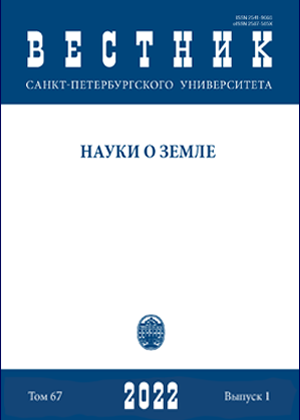The method of economic-geographic profiling of agriculture for territories with contrasting indicators of development
DOI:
https://doi.org/10.21638/spbu07.2022.106Abstract
This work explores spatial differentiation of agriculture and the identification of the existing differentiation in a territory where there are contrasts in economic development as a whole and of the agricultural sector in a particular industry. The method of economic-geographic profiling for the Inter-capital region (along the line of the Minsk-Moscow profile) was used, and dynamics for the last 10 years were investigated. Approaches are proposed for the use of profiling to identify possible growth centers that can become drivers of agricultural development, as well as depressed areas that need to be developed primarily with the help of various instruments of interethnic and regional policy. The most important role in the development of depressed areas can be played by agriculture, which is characterized by short production cycles and the ability to quickly introduce innovations that inevitably arise in cross-border cooperation due to the flow of knowledge and technology, and exchange of experience and cooperation. Because of the profile, two emerging territorial agrarian clusters in Belarus were identified. Also, quantitatively and qualitatively, the gap at the level of agricultural development between the two states was highlighted, which turned out to be more significant than expected (for some product categories by more than an order of magnitude). Profiling for different time periods includes main trends in agricultural development of the Intercapital Region: gravitation of agriculture towards the centers of districts (agropolisation), polarization and the outrunning development of the Russian sector in recent years of the import substitution policy. With this influence of the capitals of the two countries and capacious consumer markets, the formation of high-intensity suburban agriculture is not shown at this stage. The absence of the influence of the inter-capital situation for the peripheral territories of Belarus and Russia is shown.
Keywords:
agriculture, profiling, Union State, inter-capital territories, depressed regions
Downloads
References
Бабурин, В. Л., Даньшин, А. И., Катровский, А. П. (2019). Роль границ в формировании специализации сельского хозяйства западного порубежья России. Вестник Санкт-Петербургского университета. Науки о Земле, 64 (3), 388–402. https://doi.org/10.21638/spbu07.2019.301
Беручашвили, Н. Л., Жучкова, В. К. (1997). Методы комплексных физико-географических исследований. М.: Изд-во МГУ.
Бородина, Т. Л., Веденин, Ю. А., Вендина, О. И., Махрова, А. Г., Плужников, В. Н., Разумовский, В. М., Трейвиш, А. И., Аверкиева, К. В., Нефедова, Т. Г. (2015). Путешествие из Петербурга в Москву: 222 года спустя. Т. 2: Путешествие из Петербурга в Москву в XXI веке (по итогам экспедиции 2013 года), науч. ред. К. В. Аверкиева, Т. Г. Нефедова. М.: ЛЕНАНД.
Глазовская, М. А. (1998). Теория природных и техногенных ландшафтов СССР. М.: Изд-во МГУ.
Гусенок, М. И. (2017). Территориальные особенности развития сельского хозяйства в районах Витебской области. Весцi БДПУ. Серыя 3. Фізіка. Матэматыка. Інфарматыка. Біялогія. Геаграфія, 1, 40–45.
Катровский, А. П., Ридевский, Г. В. (2017). Сельское хозяйство российско-белорусского приграничья: тенденции развития и трансформация отраслевой и территориальной структуры. Региональные исследования, 4(58), 105–115.
Марцинкевич, Г. И., Счастная, И. И. (2014). Ландшафтоведение: учебное пособие. Минск: ИВЦ Минфина.
Министерство здравоохранения РФ. [online] Доступно на: https://www.rosminzdrav.ru/opendata/7707778246-normpotrebproduct/visual/ [Дата доступа: 20.02.2021].
Морачевская, К. А., Довгалюк, М. В., Зиновьев, А. С., Краснов, А. И. (2018). Адаптация молочной отрасли регионов российско-белорусского приграничья к политическим и экономическим изменениям 2010-х годов. Региональные исследования, 4 (58), 115–125.
Морачевская, К. А., Зиновьев, А. С., Краснов, А. И., Краснова, М. В. (2020). Динамика территориальной структуры молочной отрасли российско-белорусского приграничья в 2010-е годы. Вестник Московского университета. Серия 5. География, 3, 63–72.
Морачевская, К. А., Лыжина, Е. А. (2020). Институциональные градиенты в российско-белорусском приграничье (на примере условий развития агропромышленного комплекса). Балтийский регион – регион сотрудничества – 2019: материалы III Международной научно-практической конференции: в 2 ч., под ред. Г. М. Федорова, Л. А. Жиндарева, А. Г. Дружинина, Т. Пальмовского. Калининград: Балт. фед. ун-т им. И. Канта, 190–201.
Нефедова, Т. Г., Трейвиш, А. И. (2013). Россия между двумя столицами: специфика территориальных сдвигов. Региональные исследования. 4, 31-43.
Петченко, В. И., Алимарданова, М. К., Петченко, А. А. (2015). Пищевая ценность функциональных продуктов для школьного питания. Уфа: Инновационная наука.
Ракецкий, П. П., Казаровец, Н. В. (2009). Промышленное птицеводство Беларуси, под общ. ред. П. П. Ракецкого. Минск: БГАТУ.
Федеральная служба государственной статистики (2006). Постановление Федеральной службы государственной статистики от 25 декабря 2006 г. № 82 Об утверждении Методических указаний по составлению годовых балансов продовольственных ресурсов (с изменениями на 21 октября 2013 года) Москва. [online] Доступно на: https://docs.cntd.ru/document/902024138 [Дата доступа: 20.02.2021].
Федосеев, В. И. (1986). Сельское население региона. М.: Мысль.
Downloads
Published
How to Cite
Issue
Section
License
Articles of "Vestnik of Saint Petersburg University. Earth Sciences" are open access distributed under the terms of the License Agreement with Saint Petersburg State University, which permits to the authors unrestricted distribution and self-archiving free of charge.






